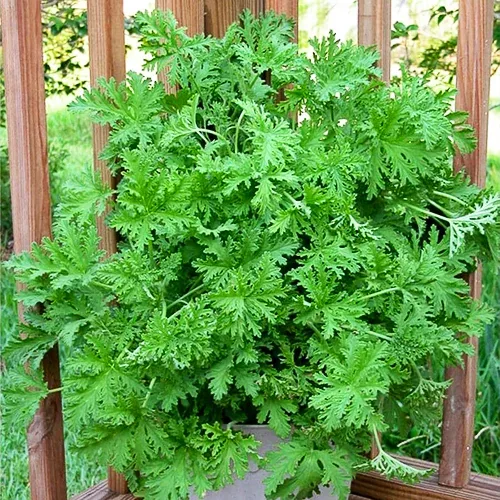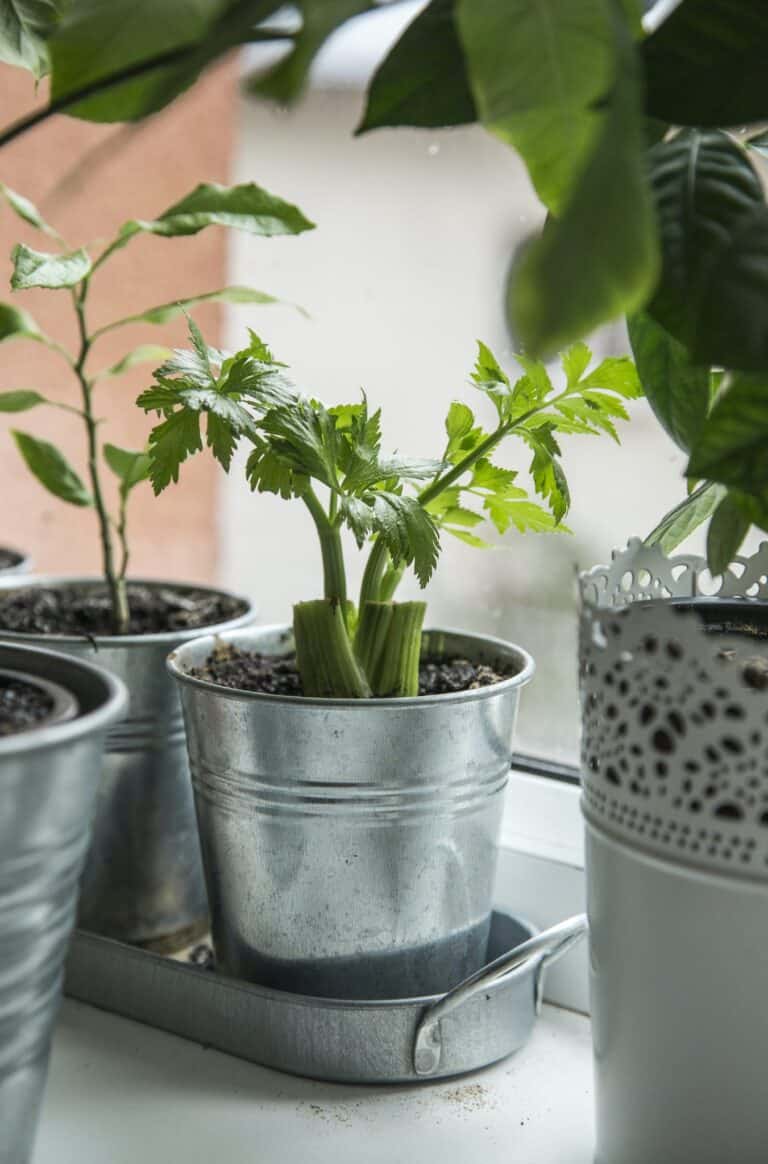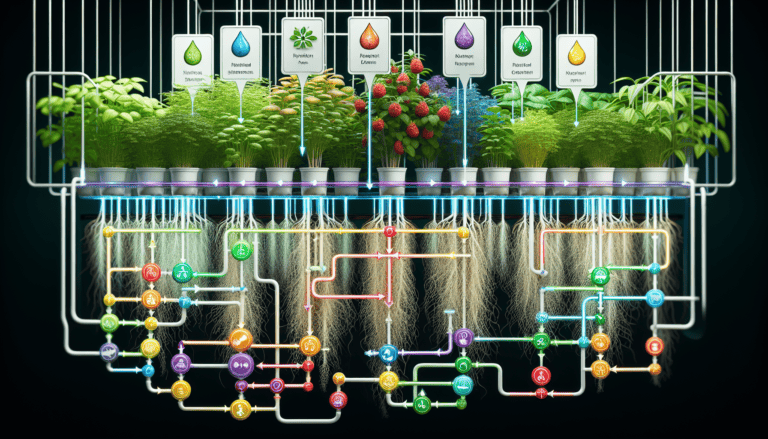Mastering Root Cellar Storage: Tips and Tricks for Beginners
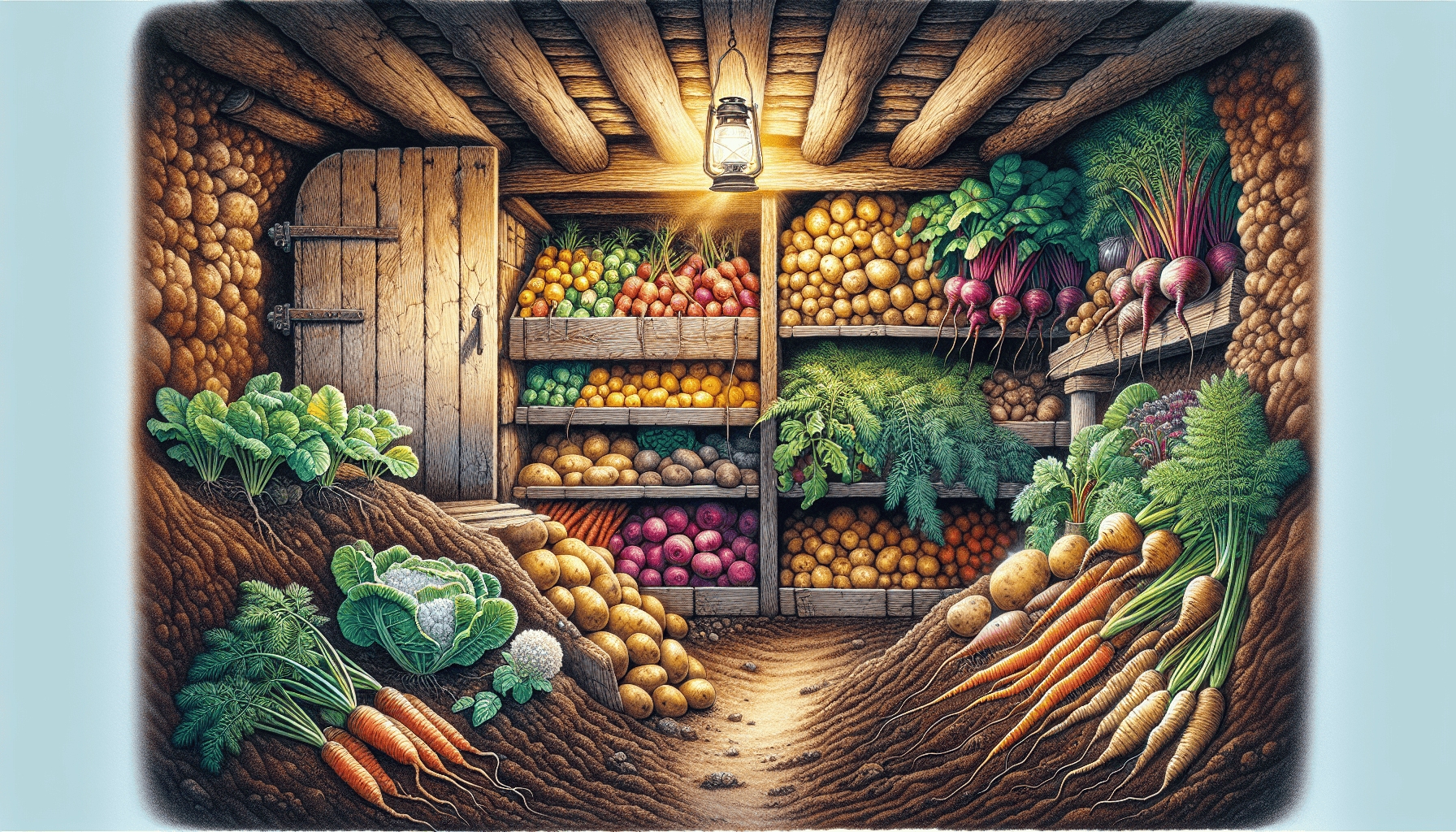
In this article, we provide guidance on understanding, constructing, and utilizing root cellars – subterranean storage areas that maintain a cool and steady temperature to keep food fresh. They are particularly suited for the long-term preservation of fruits and vegetables without relying on electrical power.
Key Takeaways
Root cellars are an eco-friendly solution for long-term food storage, maintaining optimal conditions for produce without relying on electricity.
Key factors for effective root cellar storage include managing temperature, humidity, ventilation, and darkness to extend the shelf life of fruits and vegetables.
Building and maintaining a root cellar can enhance food security and sustainability, providing fresh produce year-round while reducing food waste.
Understanding Root Cellars

Root cellars are time-honored structures that have been used for centuries to store food, particularly root vegetables and fruits. These underground storage spaces leverage the earth’s natural insulating properties to maintain a stable, cool environment, ideal for preserving produce long-term. Before the advent of refrigeration, traditional root cellars were essential for keeping vegetables like carrots and potatoes fresh throughout the year. Even today, they offer a low-energy, low-maintenance solution for those seeking to store root vegetables and preserve their harvest sustainably.
One of the key advantages of root cellars is their ability to maintain a consistent temperature, which is crucial for the longevity of stored produce. Being underground helps keep them cooler in the summer and prevents freezing in the winter. This natural temperature regulation makes root cellars an effective and eco-friendly option for food storage.
Understanding the various types of root cellars and their specific benefits will help you choose the best option for your needs. From traditional underground root cellars to modern basement adaptations, each type has its unique advantages and challenges.
The Role of Root Cellars in Modern Food Storage
At a time when self-reliance and ecological consciousness are becoming more prevalent, root cellars have been gaining renewed interest. They serve as an effective method to store food without the need for electricity, appealing to those aiming to lower their environmental impact. By keeping edibles fresh and of good quality without refrigeration, root cellaring enables substantial energy conservation and supports eco-friendly living.
By offering an independent system that isn’t vulnerable to electrical disruptions, root cellars bolster food security—something especially valuable for individuals like homesteaders or gardeners who aspire towards self-sufficiency in preserving their produce. Root cellarings’ ability to prolong the life span of perishable goods ensures access to a consistent supply of vegetables throughout all seasons.
Root cellars also play a pivotal role in curtailing food waste. By sustaining ideal conditions for storage, they prevent premature deterioration common in less regulated settings, which helps lessen spoilage while ensuring consumables remain safe and nutrient-rich.
Common Types of Root Cellars
Root cellars come in various forms, each tailored to meet specific requirements and adapt to different settings. For homeowners looking to maximize their existing space, basement root cellars are a common option. These leverage the natural insulation of home foundations to preserve cool temperatures essential for food storage, but may need extra measures for adequate air circulation and moisture control.
For those with ample exterior land who are prepared for more substantial construction efforts, outdoor root cellars embedded into hillsides or excavated underground present an exceptional means of maintaining consistent temperatures through their earth-covered structures. Such traditional methods of creating root cellars are well-suited for effective long-term storage but necessitate meticulous attention during planning stages to secure proper thermal insulating properties and airflow systems.
Regardless of which style you opt for—be it one within your house’s foundation or a classic outdoor version—the critical factor remains constant: ensuring that your chosen approach delivers on all fronts required by reliable food preservation techniques. By carefully weighing the benefits against potential complications inherent in each model, you can determine the most suitable type of cellar that aligns with both personal needs and environmental conditions conducive to constructing an efficient underground root cellar system.
Key Factors for Effective Root Cellar Storage
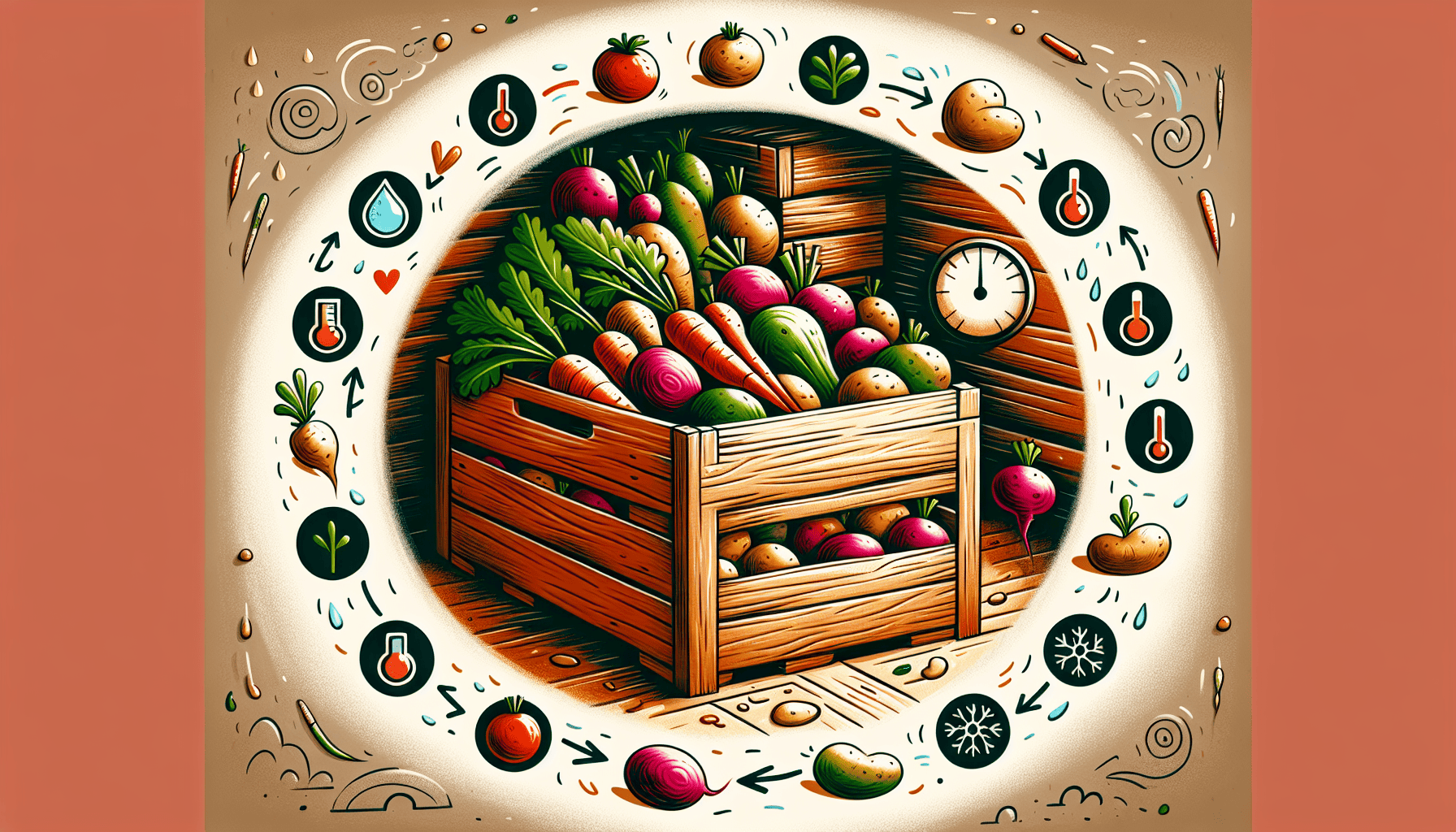
Maintaining the right environment within a root cellar is vital to ensure that food remains well-preserved. There are four central aspects to be managed:
Temperature
Humidity
Ventilation
Darkness
It’s critical for these factors to work harmoniously, as they all play an integral part in keeping your vegetables fresh and extending their shelf life.
The temperature along with humidity takes precedence since both greatly influence how long stored produce maintains its quality and freshness.Ventilation steps in as another significant factor by preventing the accumulation of ethylene gas and surplus moisture, which can cause premature spoilage and fungal growth.
Darkness plays an indispensable role. It helps deter sprouting while also preserving essential nutrients found within crops.With adept control over these variables inside your root cellar, you have the ability to establish an optimal storage condition that will considerably prolong the usable life of your produce—ensuring sustained freshness and high nutritional value.
Ideal Temperature and Humidity Levels
To properly store root vegetables in a root cellar, it’s best to keep the temperature between 32-40°F. Such cooler temperatures inhibit respiration rates of the stored produce, effectively prolonging their shelf life. Root vegetables like carrots and beets are particularly suited for this temperature range. Consistent maintenance of these cool conditions is critical to avoid spoilage and sustain the quality of your root vegetables.
The humidity level is also vital when storing root vegetables. An ideal range falls between 85% and 95%. At high humidity levels, evaporation from the produce is minimized, helping preserve moisture content which keeps them fresh longer. It’s imperative to monitor these environmental factors regularly. Digital thermometers and hygrometers can aid in tracking any changes within your storage space with precision.
For more meticulous management of the environment where you’re keeping your root crops, consider utilizing Bluetooth-enabled sensors that offer immediate updates on both temperature and humidity variations inside your cellar. By maintaining optimal conditions regarding both variables—temperature range within 32-40°F and humidity levels at about 90%—you’ll significantly enhance not only the freshness but also extend the lifespan of those veggies tucked away for storage.
Proper Ventilation
Effective air circulation is essential in a root cellar, as it wards off the accumulation of ethylene gas, which expedites both ripening and decay in stored goods. To stave off excess moisture that may lead to mold growth and spoilage, proper ventilation plays an indispensable role.
Installing two vents — one near the ceiling for venting out stale air and another close to the ground to draw in fresh air — can promote optimal air flow. This layout encourages continuous exchange of internal and external air, effectively managing humidity levels inside the cellar while keeping mold at bay.
In regions where high ambient moisture prevails, using a dehumidifier might be beneficial for regulating humidity within your root cellar. Through these targeted strategies focused on maintaining ample airflow, you’ll better preserve your produce over extended periods.
Maintaining Darkness
Ensuring the absence of light is essential for the efficacy of root cellar storage. Allowing stored produce to come into contact with light may prompt sprouting and a decrease in their nutritional content. To achieve total darkness, it’s vital to close off any potential entry points that could permit light penetration. Employing materials that block out light from windows or other sources is key to maintaining an environment devoid of illumination.
By preserving complete darkness within your root cellar, you ward off unwanted growth and sustain the nutrient density of your produce. Consequently, this practice plays a significant role in enhancing both the quality and longevity of shelf life for vegetables kept in storage.
Building Your Own Root Cellar
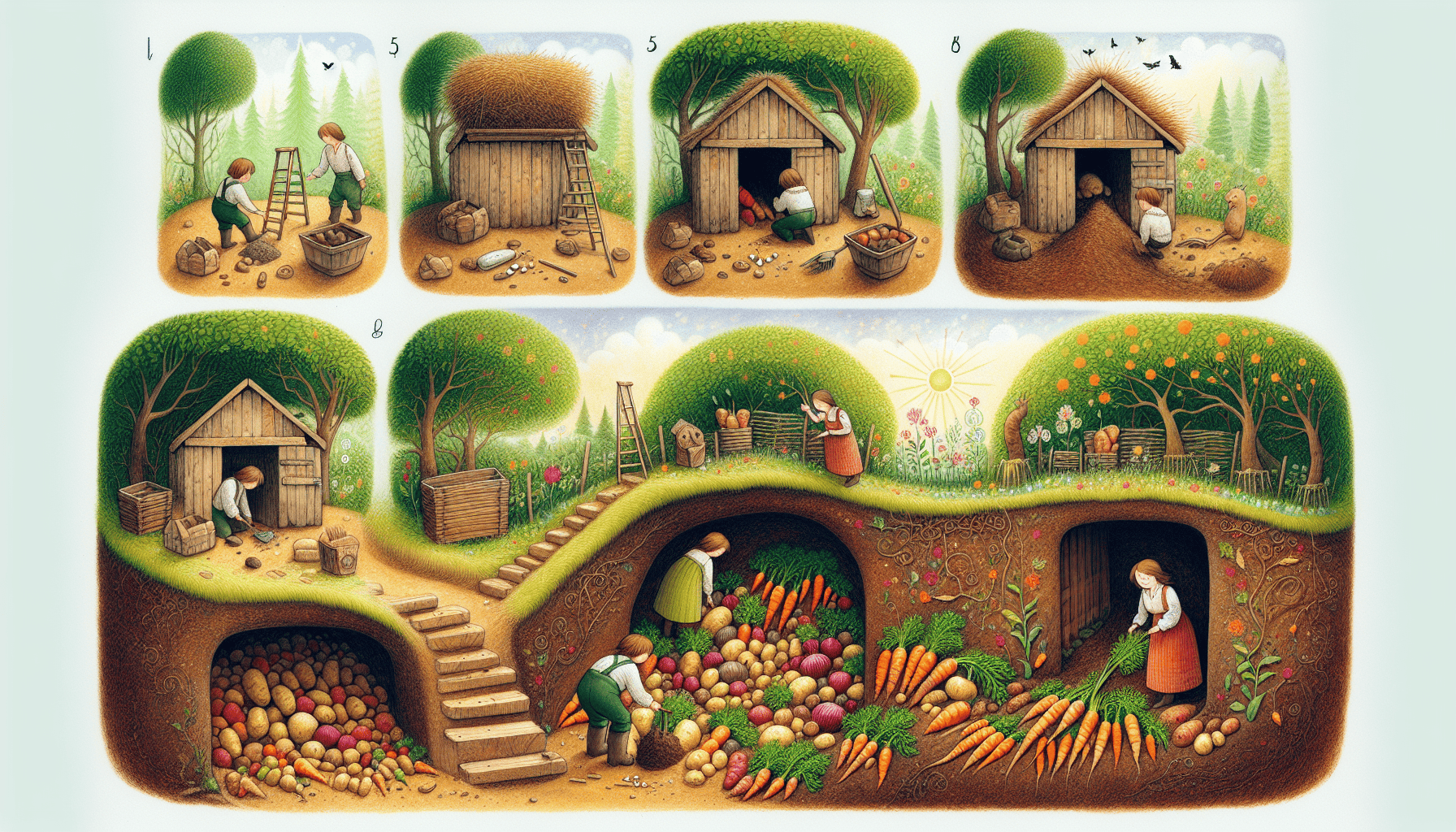
Creating a root cellar of your own is an enriching endeavor that offers a sustainable, environmentally friendly option for preserving food. With meticulous planning and thoughtfulness put into the undertaking, the reward of possessing a custom-designed space to keep your produce fresh can be substantial. A well-constructed root cellar will greatly lengthen the lifespan of your fruits and vegetables, affording you access to homegrown nourishment throughout all seasons.
Embarking on the construction of a root cellar comprises various stages which include picking an ideal spot as well as procuring appropriate supplies and equipment. Familiarizing yourself with both essential requisites and methods ensures that your root cellar performs optimally and stands resiliently over time. Whether integrating within an existing structure such as modifying part of one’s basement or establishing it fully outdoors, success hinges on crafting conditions tailored specifically towards optimal preservation for your carefully harvested goods.
Prior to setting out on this project, ensure you have plotted comprehensively while also being ready for labor demands accompanying this task. This narrative will navigate through pivotal steps along with critical points worth considering when constructing a personalized outdoor or indoor storage area—offering handy advice poised at bolstering chances for triumphant outcomes in food storage endeavors.
Selecting the Right Location
The choice of a suitable location is pivotal for preserving the correct conditions required in an effective root cellar. The preference often lies with outdoor root cellars due to their proficiency at sustaining cooler temperatures with ease. Traditional construction approaches usually involve excavating into or alongside a hill, leveraging earth’s natural insulative properties.
When pinpointing a spot, it’s important to take into account both accessibility and convenience when moving produce in and out of the cellar. Opting for an entrance facing north can contribute significantly to cooling by shielding it from direct sunlight exposure. It is also crucial to enhance soil drainage using gravel and stones, aiding moisture control and thwarting water buildup.
To facilitate usage and upkeep, incorporating adequate access features like insulated doors into your root cellar design is key. By making deliberate choices regarding its placement and the site preparation techniques you employ, you are setting up your root cellar for ideal performance.
Essential Materials and Tools
Constructing a root cellar involves gathering numerous materials and implements. Key supplies include timber, concrete, stones, clay bricks, concrete blocks, and eco-friendly alternatives like old tires. The financial investment for these resources is substantial. Thus meticulous planning of finances is critical.
Opting for reused items such as repurposed tires in the walls can be economical. For earth removal purposes, when creating more extensive cellars, machinery like backhoes or excavators proves extremely useful. An area measuring 8 by 8 feet will require roughly 350 cinder blocks—a fact underscoring the importance of precise material calculations before beginning your project.
The efficiency and ease of construction are enhanced significantly with access to appropriate tools and components from the start. By securing high-quality materials ahead of time and thoroughly preparing for your build-out phase, you’re paving the way toward realizing a sturdy and enduring root cellar.
Construction Steps
When embarking on the construction of a root cellar, it is imperative to follow crucial steps to guarantee both its durability and utility. Begin with excavating the required area and establishing a robust base. Support for walls and ceilings must be adequate to prevent collapses while safeguarding the stored produce. An arched roof configuration is advised as it promotes moisture runoff. Steer clear of flat-surface roofs.
Upon completion of your build, fit a door that will shield against weather conditions. To implement solid stairs facilitating secure entry. A French drain system can be an effective solution for diverting surface water away from the cellar, thus keeping infiltration at bay. It’s critical that you employ several tons of concrete for roofing purposes so that stability is assured.
Prioritizing safety means waiting until the concrete has thoroughly set before using the root cellar — this mitigates potential hazards associated with premature usage. Diligently adhering to these specified construction guidelines ensures you create a resilient structure aptly suited for food storage needs over time.
Storing Different Types of Produce
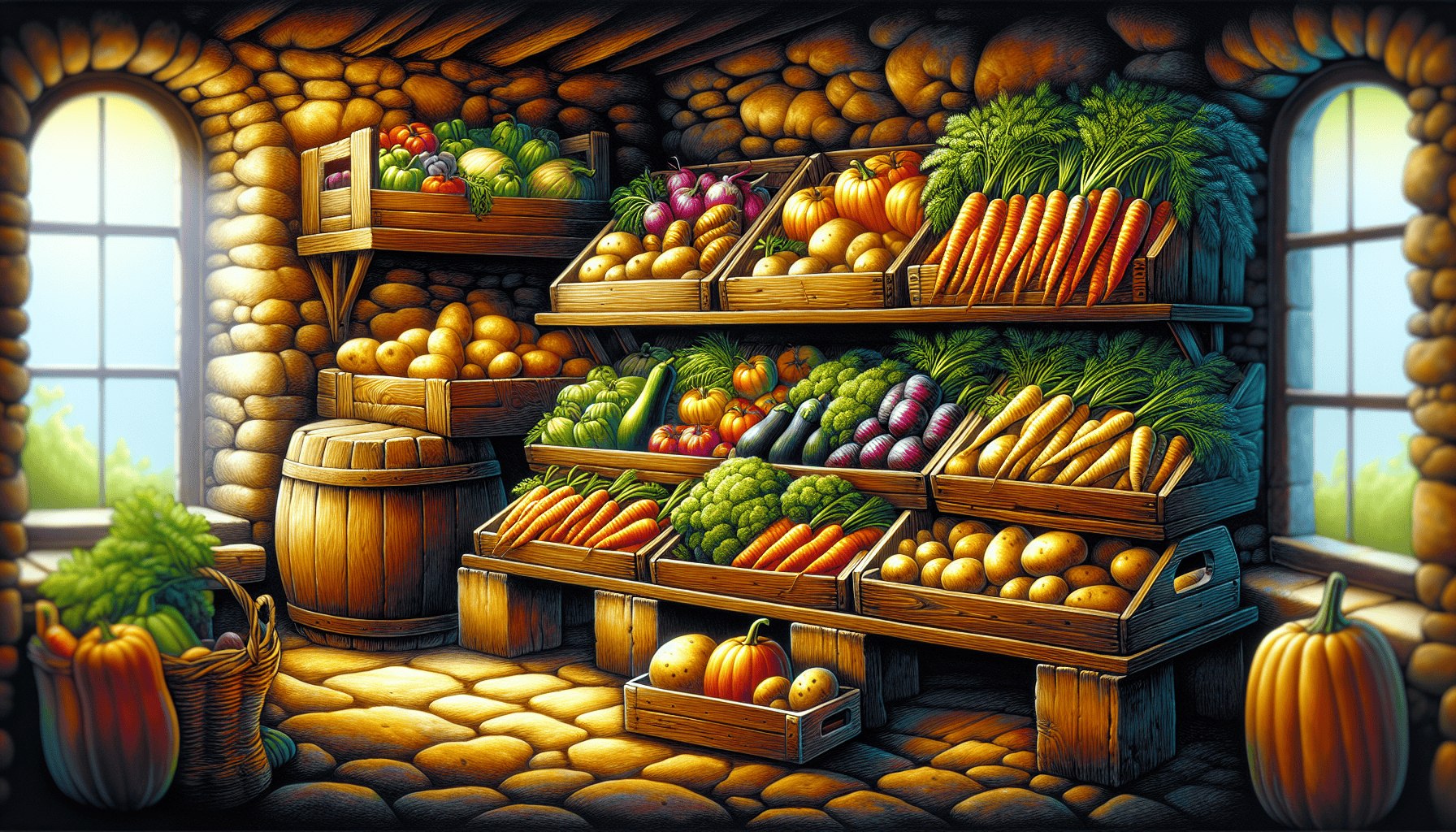
Grasping the particular needs of different vegetables is key to successful storage within a root cellar. Root cellars are particularly well-suited for robust produce such as apples, potatoes, and carrots. They may not be suitable for more delicate items like leafy greens. To retain produce freshness in a root cellar setting, it should maintain cool temperatures with low light exposure and high humidity.
Strategic organization and proper preparation of your vegetables prior to placing them in the root cellar can greatly extend their shelf life. By adopting these measures, you enhance both the space efficiency and functionality of your food storage area, which enables you to keep an assortment of vegetables fresh throughout all seasons.
To fully benefit from utilizing a root cellar for storing foodstuff effectively requires knowledge on how best practices apply across various types of produce. The upcoming section will offer essential advice regarding how to arrange and prepare your veggies so that ideal preservation conditions are maintained inside your root cellar.
Preparing Vegetables for Storage
Ensuring that vegetables are properly prepped prior to storage is vital for keeping them fresh and prolonging their shelf life. Before being stored, various vegetables such as potatoes, squash, garlic, and onions should undergo a curing process which helps in thickening their skins and extending their lifespan. For effective curing of potatoes specifically, they need to be placed in an area devoid of light with elevated humidity levels for approximately one week.
In situations where vegetables have soil on them necessitating washing off the dirt before storage, it’s important to towel-dry them afterward to minimize moisture retention since this can foster mold development. It’s preferable to brush the dirt off using a dry cloth instead of washing the veggies so as not Increase water absorption into the produce. To keep root crops at optimum freshness during storage due to high humidity needs could also entail utilizing moist bedding materials like sand or sawdust.
Consuming fruits or vegetables showing signs of damage first is recommended because storing these compromised items alongside others may lead to contamination spreading throughout your stores via mold growths and other harmful agents. Focusing on preparing your produce appropriately will create ideal conditions necessary to maximize both longevity taste nutritional benefits offered by our foodstores.
Organizing Your Root Cellar
Optimizing the layout of your root cellar can greatly improve its overall capacity and operational effectiveness. By implementing vertical storage solutions such as shelves, you are able to expand the amount of available space for storing additional produce while avoiding congestion. The use of stackable bins and vertical shelving is an effective method for enhancing organization and making full use of the room in your root cellar.
It’s critical to keep strong-scented crops like cabbage isolated from other items in order to avert flavor transfer that could compromise the taste and quality of neighboring produce. To contain these potent aromas, consider using sealed containers which will safeguard other goods from unwanted scents.
Well-considered arrangement encourages conditions conducive to preserving produce at its peak state, decreasing decay rates and prolonging shelf life. Employing these tactics for orderly arrangement results in an efficiently structured root cellar that ensures both ease-of-accessibility as well as favorable preservation environments suitable for a variety of agricultural products.
Managing Ethylene-Producing Crops
Certain fruits like apples and pears release ethylene gas, which can cause spoilage in nearby vegetables that are sensitive to it. To prevent this from happening, fruits should be stored separately from vegetables. Encasing ethylene-emitting fruits in newspaper prior to putting them away may also reduce their effect on other produce.
Efficiently handling crops that emit ethylene is essential for preventing early ripening and decay of your stored goods. By applying these methods, you will uphold the freshness and edibility of your items within root cellar storage.
Troubleshooting Common Root Cellar Issues
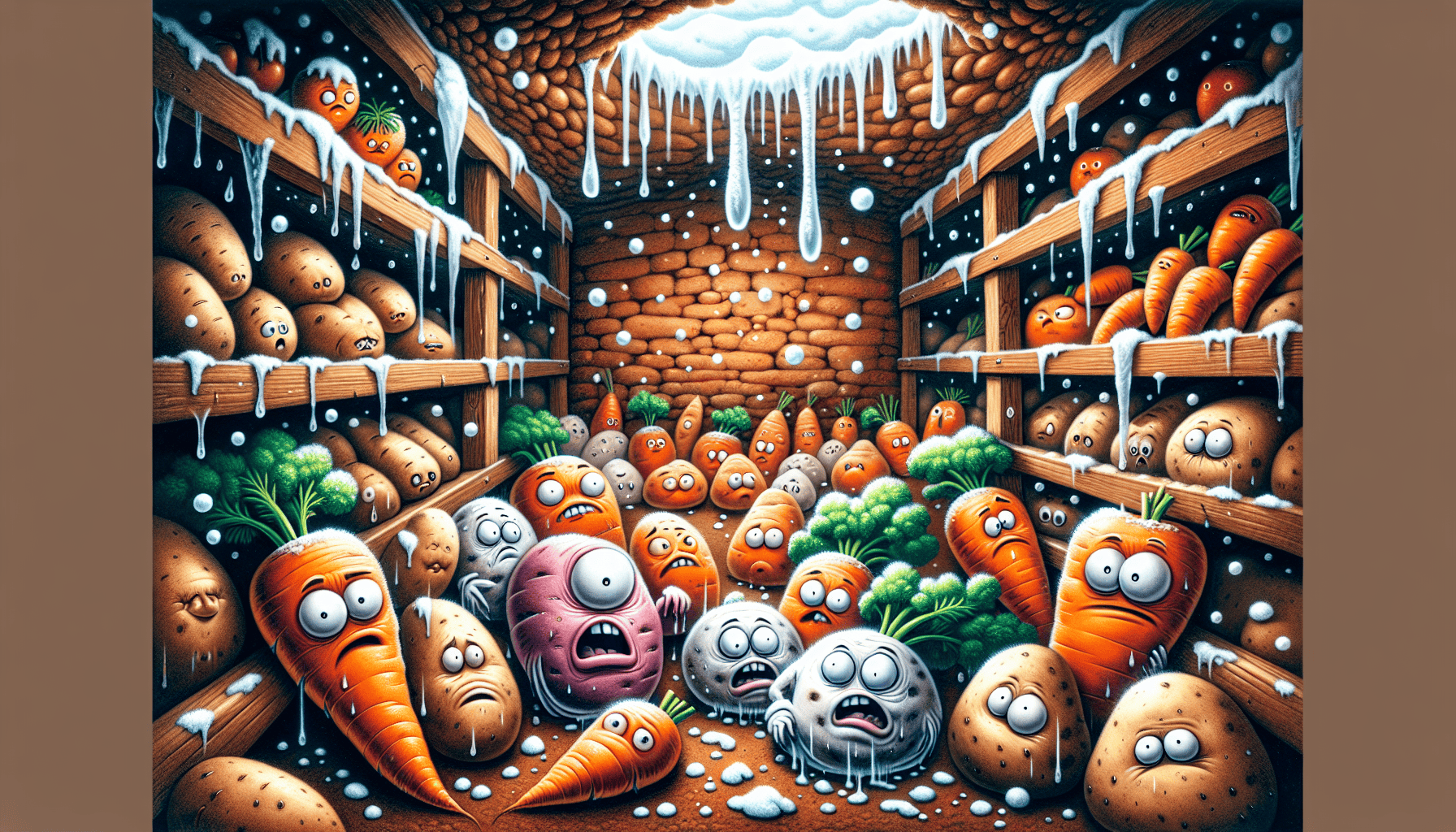
Even with diligent care, certain challenges such as excess moisture, the risk of freezing temperatures, and the presence of strong odors can arise when operating a root cellar. To keep these issues in check and sustain ideal conditions for storage, consistent upkeep and vigilance are imperative.
Recognizing what leads to such problems is crucial for remediation. With a clear grasp on why these complications occur and by applying practical corrective measures, you will be able to preserve your root cellar’s effectiveness in safeguarding your harvest.
Dealing with Excess Moisture
Maintaining proper humidity levels is essential to prevent the deterioration of produce stored in a root cellar. Vegetables should be preserved using moist materials like sand or sawdust, yet one must avoid adding an excessive amount of water as it increases the likelihood of mold and bacterial contamination.
Ensuring good air circulation through adequate ventilation is vital for mitigating moisture accumulation. By fitting air vents, one can regulate the humidity inside the root cellar and discourage mold growth.
Dealing with excess moisture effectively guarantees a more conducive storage condition for your harvested goods, thus promoting their longevity.
Preventing Freezing
Stored produce can be detrimentally impacted by freezing temperatures, which compromise the texture of vegetables and elevate their chances of spoilage due to a mushy consistency. When faced with intense cold conditions, it’s crucial to shield food by relocating it from proximity to doors and vents while also momentarily sealing vents in order to block frigid air from infiltrating the storage area.
Adopting such measures is essential for safeguarding your stored produce against the harmful consequences brought on by sub-zero temperatures. This proactive approach will help maintain the freshness and consumability of your produce during winter.
Addressing Odor Issues
Issues with odors in a root cellar can impact the quality and freshness of produce being stored. It’s important to isolate crops that emit strong smells from other produce since such aromas can be absorbed by nearby foods. Employing distinct containers or specific sections within your root cellar for pungent-smelling crops is an effective strategy to curb odor dispersion.
Maintaining proper ventilation is crucial in effectively controlling odors. Good air circulation plays a significant role in eliminating robust scents and preserving a clean atmosphere inside your root cellar. Dealing swiftly with any problems related to odors ensures the taste and integrity of your stored produce remains intact.
Enhancing Your Root Cellar Experience
To improve the functionality of your root cellar, it’s crucial to employ sophisticated practices and maintain consistent upkeep for prime storage conditions. Key components include vigilant oversight of temperature and humidity levels, conducting maintenance in accordance with the seasons, and increasing space available for storage.
By being proactive and responsive to the requirements of your root cellar, you can establish a more productive and successful preservation environment for your foodstuffs. In this section, we will offer guidance and techniques designed to elevate your experience with using a root cellar while fully leveraging its conventional use as a method of storing produce.
Monitoring Conditions
It is crucial to consistently keep an eye on the temperature and humidity levels in your root cellar for ideal storage settings. Essential instruments like temperature gauges and hydrometers are key to effectively tracking these variables. With a hydrometer, you can accurately gauge the humidity levels while a thermometer allows you to observe any changes in temperature, enabling timely modifications.
By vigilantly overseeing these environmental factors, you can avoid complications such as freezing or excess moisture accumulation. This diligence helps maintain the freshness and longevity of your stored produce.
Seasonal Maintenance
Maintaining your root cellar’s efficiency is essential, and this involves regulating humidity levels, keeping the space clean, and carrying out repairs to avert mold and decay. The period of harvest season presents a perfect opportunity for conducting comprehensive inspections and upkeep in anticipation of storing new crops.
Regular maintenance activities are vital to preserve the optimal state of your root cellar, allowing it to remain an effective storage option for your produce continuously.
Expanding Storage Capacity
Enhancing your root cellar’s ability to hold more produce can lead to fresher and longer-lasting food. By constructing shelving or piling up boxes, you can take advantage of vertical space which facilitates the efficient storing of food. Grouping like items in bins or containers helps prevent decay and optimizes usage of confined areas.
Adopting a system that rotates goods seasonally assists in clearing out space as specific crops are consumed, paving the way for incoming harvests. Optimizing the storage capabilities in this manner improves both function and efficiency within your root cellar.
Summary
Grasping the essentials of root cellar storage is pivotal for effective preservation of food. This encompasses a thorough understanding of crucial elements like humidity, temperature, darkness, and adequate airflow. Taking on the project to construct your own root cellar as well as preparing vegetables suitably are vital steps towards an ideal environment for storing goods. Strategic organization within your root cellar along with proper management of crops that emit ethylene can significantly enhance the durability and condition of your produce.
It’s imperative to tackle frequent problems including excess moisture, potential freezing conditions, and unwanted odors in order to maintain a conducive atmosphere for stored items. Diligent observation along with routine upkeep each season is necessary to keep your root cellar functioning at its best capacity which ensures it remains a dependable and proficient method for keeping food.
By employing techniques and advice provided in this manual you have the opportunity to refine how you use your root cellaring system while reaping the rewards from sustainable methods that favor eco-friendly approaches toward food storage. Adopting age-old practices such as those used in traditional rooting cellaring allows one not only mastery over their own homegrown supplies but also guarantees access throughout different seasons annually to fresh produce originating right from one’s garden or homestead.
Frequently Asked Questions
What temperature and humidity levels are ideal for a root cellar?
To ensure your root cellar operates effectively, it’s critical to maintain temperature ranges from 32 to 40 degrees Fahrenheit coupled with humidity levels ranging from 85% to 95%.
Maintaining these specific conditions is key for preserving the freshness and longevity of your vegetables!
How can I prevent my root cellar from freezing in extreme cold?
To safeguard your root cellar from the grasp of freezing temperatures, shift your foods away from any openings such as vents and doors. You may also want to think about sealing the vents for a short period to obstruct cold air from invading.
Implementing this straightforward modification can be instrumental in shielding your produce and ensuring that the conditions within remain constant!
What should I do if my root cellar has excess moisture?
In order to address the issue of excess moisture, it is important to maintain proper ventilation within your root cellar. Using materials such as sand or sawdust can assist in controlling the humidity levels when covering your vegetables.
By taking these measures, you will foster a more suitable atmosphere for preserving your stored produce!
How can I control odors in my root cellar?
To manage odors in your root cellar efficiently, it’s important to segregate crops with potent aromas and store them in containers that are sealed tightly.
Incorporating proper ventilation is essential too, as it will greatly enhance the freshness of the area, making it a more pleasant space.
What are the benefits of building an outdoor root cellar?
Constructing a root cellar outdoors provides an excellent method for keeping your fruits and vegetables fresh for extended periods, leveraging the inherent ability of such structures to maintain steady temperatures.
The joy comes from knowing you are preserving your harvest both effectively and in a manner that ensures it remains tasty!

